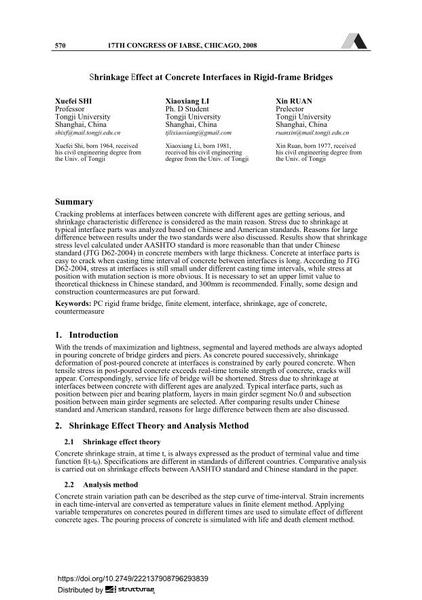Shrinkage Effect at Concrete Interfaces in Rigid-frame Bridges

|
|
|||||||||||
Bibliografische Angaben
| Autor(en): |
Xue-fei Shi
Xiaoxiang Li Xin Ruan |
||||
|---|---|---|---|---|---|
| Medium: | Tagungsbeitrag | ||||
| Sprache(n): | Englisch | ||||
| Tagung: | 17th IABSE Congress: Creating and Renewing Urban Structures – Tall Buildings, Bridges and Infrastructure, Chicago, USA, 17-19 September 2008 | ||||
| Veröffentlicht in: | IABSE Congress Chicago 2008 | ||||
|
|||||
| Seite(n): | 570-571 | ||||
| Anzahl der Seiten (im PDF): | 6 | ||||
| Jahr: | 2008 | ||||
| DOI: | 10.2749/222137908796293839 | ||||
| Abstrakt: |
Cracking problems at interfaces between concrete with different ages are getting serious, and shrinkage characteristic difference is considered as the main reason. Stress distribution due to shrinkage at typical interface parts was analyzed based on Chinese and American standards. Reasons for large difference between results under the two standards were also discussed. Results show that shrinkage stress level calculated under AASHTO standard is more reasonable than that under Chinese standard (JTG D62-2004) in concrete members with large thickness. Concrete at interface parts is easy to crack when casting time interval is long. According to JTG D62-2004, stress at interfaces is still small under different casting time intervals, while stress at position with mutation section is more obvious. It is necessary to set an upper limit value to theoretical thickness in Chinese standard, and 300mm is recommended. Finally, some design and construction countermeasures are put forward. |
||||
| Stichwörter: |
finites Element Schwinden
|
||||

